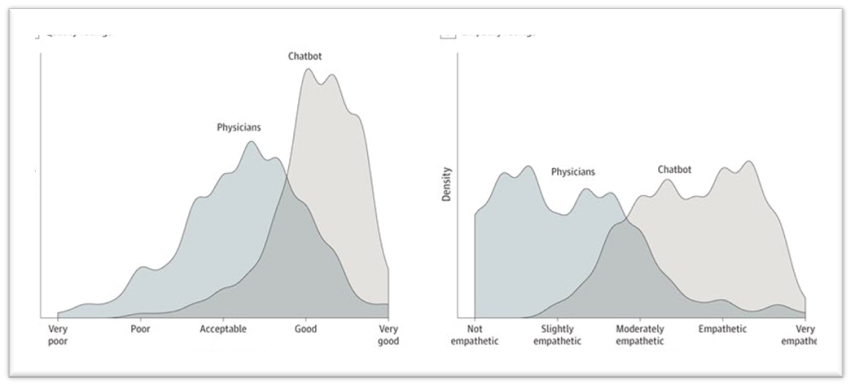
Here’s how AI is about to revolutionize health care:
Overall, patients preferred the chatbot over the physician 79% of the time. This is amazing for a technology that has been out for about six months. One can only imagine where we will be a year from now.
According to the study: “The chatbot responses were preferred over physician responses and rated significantly higher for both quality and empathy.” Some physicians scored a “very poor” score on Quality ratings as Empathy also scored on the lower side of ratings.

Notably, some questions received a 100% preference for the chatbot over the physician. The overall quality and empathy improvement in ChatGPT’s answer is apparent, as is the thoroughness of the answer.
Here is an example of the exchange between the two forms when a theoretical patient asks about the risk of swallowing and ingesting an ordinary toothpick.

The virtual assistant’s reply is more personable and provides much more detail. It provided recommendations on what if any, symptoms to be looking for.
In these following scenarios, the patient is a bit more concerned and is determining whether a visit or an appointment is needed.


To be sure, there is still much work to be done. Sometimes, the virtual assistant may provide too much information and not get to the point. Here is a question where the physician scored better than the virtual assistant. Presumably, because the physician was straight to the point with treatment after the diagnosis, the virtual assistant provided helpful information but was less direct than its approach.

As AI continues to improve, a 79% preference will rise ever closer to 100%.
So, what are the potential implications?
Ideally, I expect the following benefits to be realized:
1. Health guidance is available 24/7.
More sophisticated and intuitive than web searches, conversational context will be more engaging with patients and families needing help at any time. We have pilot programs underway. I’ll post our findings in a future article.
2. Quicker results.
I work with pediatric hospitals, and new parents have many questions that, while not emergencies, still require quick answers. Obtaining guidance from an always-available virtual assistant is faster than waiting for a call back from a provider.
3. Increased availability of healthcare in rural and underserved areas.
Access to medical information should be unrestricted by geographical location and proximity to healthcare locations. Even emergency cases can be addressed until the patient can get to a hospital for proper care.
4. Decreased workload in healthcare systems.
Hospital call centers are often inundated with calls that this chatbot can handle. Chatbots may be trained to listen and look for trigger words, phrases, and attitudes requiring escalation to their human counterparts. In addition, a transcript of the patient/chatbot communication may be stored and referred for future encounters.
There are a few caveats to the study that are detailed below.
The testing method used for this study did not use a conversational virtual assistant model as offered by Druid AI, Microsoft, Google, and ChatGPT. The test was conducted via an online forum for questions and was designed to measure the quality of the response and not the patient’s experience.
Today’s conversational models are built to be engaging with the patient. They are designed to give contextual replies and will take their cues from historic data, conversation tone, and past exchanges that would not have been available in a simple post question/receive answer forum. Therefore, I expect adoption and preference to be even higher. I am excited for this new and emerging tool to be available to augment the offering and services by healthcare. The industry is under tremendous pressures to be efficient and improve the patient care and outcomes.
If you want to test AI vs. physician for yourself, here are a couple of suggestions:
1. Just ask ChatGPT
2. Try Glass AI by Glass Health
3. Try Martin Shkreli’s Dr. Gupta, powered by GPT-4
 Joe Nieto
Joe Nieto
The original version of this page was published at: https://elementblue.com/2023/06/05/ai-powered-virtual-assistants-are-poised-to-change-clinical-interactions/
Element Blue develops process automation and consumer engagement solutions for clients in Healthcare, Energy and Retail. Our Digital Experience and Robotic Process Automation (RPA) solutions trans... Read more
Companies partner to launch joint practice around optimization of mainframe RPA automationsHouston, Texas, June 2, 2020 – Element Blue, a twenty-year technology consultancy ...read more
The Problem: In order to meet the State of Texas’ requirements for the phased COVID-19 vaccine rollout and deadline, rapid implementation of a patient self-scheduling and registration ...read more
PROJECT SCOPESingle Sign-on (SSO) platformMessaging and social collaborationAppointment management functionalityOnline payments and account managementFind a Physician and location ...read more
Part One of the series focuses on exploring practical use cases. In follow-up articles, we’ll cover use case implementation, and operating and maintaining a complex platform.In ...read more